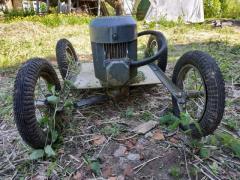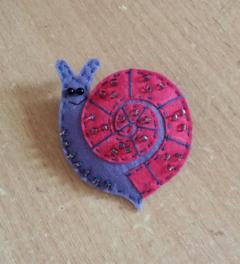Turbine for a homemade robot vacuum cleaner
It’s 2024, stores are already selling robotic vacuum cleaners, and you can even buy used ones for a reasonable price. And I still dream of assembling a robot vacuum cleaner with my own hands. Now I looked for the first article about a robot vacuum cleaner and it turned out that 10 years have passed. At that time, robots were not yet so popular; it was difficult to buy them and they were expensive.
In 2014, I didn’t have a 3D printer or CNC machine, and I didn’t have 3D modeling skills. But all this time I couldn’t get the desire to create out of my head :) And today I took my last test robot off the dusty shelf and thought that I needed to do something with it.
This photo was taken in 2018, around that time I already had a large CNC machine and I could cut out parts from plywood. I didn’t have a 3D printer yet, so I tried to cut gears out of plywood, but I couldn’t cut them small because the smallest cutter I had was 2 mm.
This was already the third model of the vacuum cleaner, it could drive, was bad at detecting obstacles, and even twisted the side brush. There is no turbo brush here, I tested the electronics, the infrared sensors work, but they are affected by the sun. Here I installed the popular yellow gearboxes, which transmitted rotation to the wheels through wooden gears.
All these years I was inspired by one of the first cool robots from the Neato company, they were probably the pioneers who made a robot with cool navigation. A laser rangefinder is installed above the body, which constantly rotates and measures the distance to objects, thus building a map of the room. Thanks to this, the robot does not vacuum the room with random movements, but moves along and across the room, cleaning the entire area several times faster than its competitors. Read more about Neato XV-11.
Video with disassembly of the Neato robot, you can see how it works inside.
In this article we will talk about turbines for homemade robotic vacuum cleaners. If we talk about Neato, then it has a snail-type fan BCB1012UH-A, supply voltage 12 volts, current consumption 3.45 amperes. I think that even after 10 years this robot has one of the most powerful turbines.
For my robot, I tried to make a turbine with my own hands; I didn’t have a 3D printer, so I glued it together from cardboard. The cardboard impeller itself turned out great, but I didn’t have a suitable motor. At the moment, it’s realistic to use a DVD drive as a motor, and print the impeller on a 3D printer, but for now we’ll put the homemade project aside.

A long time ago, I decided to buy a ready-made turbine for a robot; I came across a 1.34 ampere one, which at that time cost about $10. Fan NMB BG0903-B044-VTL, power supply 12V, current 1.34A, speed 3700RPM, dimensions 97x97x33 mm, ball bearings. In the photo, a thermistor is sticking out from under the electrical tape; it turns out that this turbine has a regulator; it turns on at full power if the thermistor gets hot. If you simply close it, the turbine turns on 100% and creates decent thrust.
A couple of years ago, I was making a soap bubble machine and I got another snail, bought from a radio parts store. SANONDA JF973312BH, voltage 12V, consumption 1.32A, dimensions 97x97x33 mm.
Both of these turbines are not expensive and are quite suitable for a homemade robot vacuum cleaner. Of course, they will not suck up dust like household vacuum cleaners, but they will work quite well in tandem with a turbo brush.
The photo below shows a couple of options for modern turbines from Xiaomi robot vacuum cleaners. The devices here are more serious and cost more. A control board with PWM is attached to the housing. I can’t say anything specific about these turbines, I haven’t held them in my hands, I haven’t found any specifications on the Internet, except for the diameter of 8 cm.
I showed two options for the most suitable turbines that can be bought in the store. There is another option, this is a commutator motor, I got it for free, I unscrewed it from an old cordless vacuum cleaner. The power of this motor is simply amazing, even in abundance for a robot. Compared to previous versions, it is about 5 times more powerful, but also noisy. Such a motor together with the impeller can also be purchased as a spare part.
Characteristics of this motor: model 540, supply voltage 12V, current up to 8A, speed 21000 rpm. Motor shaft diameter 3.17 mm, housing diameter 35.5 mm, motor length 50 mm. I’m not 100% sure that the characteristics are exactly the same, there are different modifications of this motor.
So far these are the best options that I know of. There is another option to buy a car vacuum cleaner that is powered from the car's 12 volt network, I once bought one, it turned out that it had no power at all, and it was lying around in the garage.
Add comment
Random DIY
-
They say that Russia is a technically backward country, there are no roads, robotics do not develop, rockets do not fly, and mail goes too long. It’s a bullshit.
-
Almost all toys bought for the daughter do not cause the child's interest, which can not be said about developing toys made by themselves. Below is a photo of the simplest developing mat, which the wife made for a couple of evenings from old buttons.
-
I made this powerful lawnmower myself for the village, there is always a lot of high grass, which is not rational to fight with the usual manual trimmer. This animal mows down everything, tough grass, small trees, levels of hills, covered with moles, and even turns old bricks out of the ground.
-
I had a new passion - brooches of felt. Such small, lovely - they can be an independent gift or an excellent surprise to the main.
-
I present to your attention a homemade 3d printer. Assembled from plywood, aluminum, plastic and Arduino. This printer is unique in that its kinematics is peeped from Ultimaker, but done with quality modifications.










